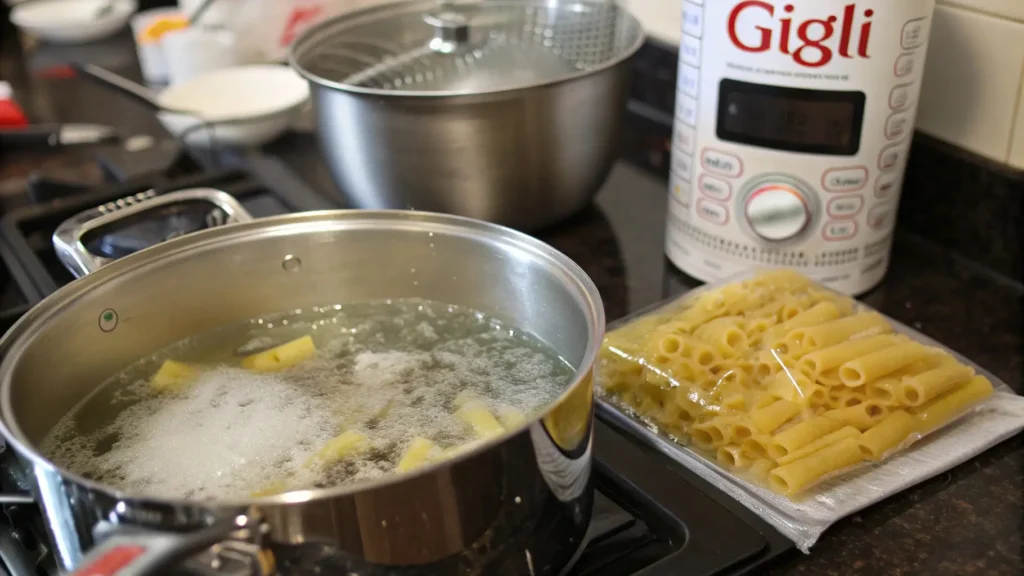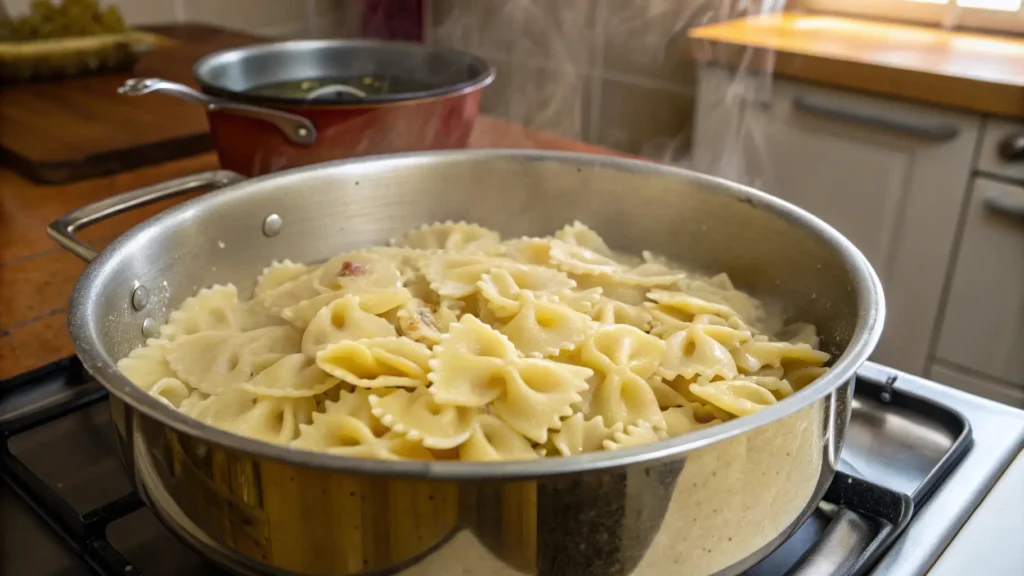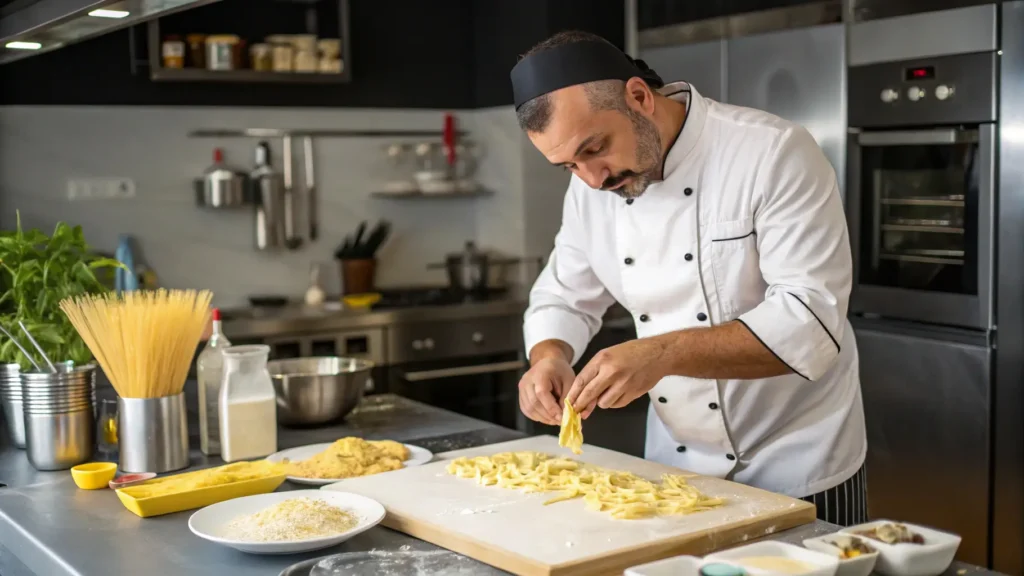Gigli pasta, with its unique bell-shaped design, is a delightful addition to any pasta lover’s repertoire. But when it comes to cooking it to perfection, there are always questions about the right technique and timing. If you’ve ever wondered, “How long do you cook gigli pasta for?” you’re in the right place. This article dives deep into everything you need to know, from preparation to troubleshooting, so you can serve a plate that’s nothing short of mouthwatering. Whether you’re a novice in the kitchen or a seasoned pasta enthusiast, these tips and tricks will elevate your cooking game.

Let’s begin by exploring the essentials of gigli pasta, including what makes it so special and why cooking it just right is key to its deliciousness.
Introduction to Gigli Pasta
What is Gigli Pasta?
Gigli pasta, also known as “campanelle,” gets its name from the Italian word for “lily.” This pasta stands out for its delicate, fluted edges and hollow, cone-like shape. Its charming appearance not only adds a visual flair to dishes but also makes it perfect for holding rich, creamy sauces or hearty vegetable fillings.
Why Gigli Pasta is Special: Its Origins and Texture
Unlike other pasta types, gigli has its roots in traditional Italian cuisine and is particularly popular in Tuscany. Its unique texture—a harmonious balance between soft and firm—makes it ideal for soaking up sauces while maintaining its shape during cooking. For those seeking a pasta that blends aesthetics with functionality, gigli is the ultimate choice.
Introduction to Cooking Gigli Pasta: Factors to Consider
When it comes to cooking gigli pasta, timing is everything. Overcooking can make it mushy, while undercooking leaves it unappealingly tough. Factors such as the brand, the type of sauce you’re pairing it with, and your desired texture (whether al dente or fully cooked) all play a role in determining the ideal cooking time. Starting with the basics ensures that your pasta turns out perfect every time.
Stay tuned as we delve into the specifics of preparing gigli pasta, ensuring every step is a success!
Preparing Gigli Pasta for Cooking
Choosing the Right Tools and Ingredients
Cooking gigli pasta starts with having the right tools on hand. A large pot, a strainer, and a wooden spoon are all you need to get started. Opt for a pot that holds at least 4 to 6 quarts of water for every pound of pasta. This ensures the pasta has plenty of space to cook evenly without sticking together.
When it comes to ingredients, fresh is best. Use high-quality dried gigli pasta, filtered water, and a generous pinch of sea salt. The salt not only enhances the pasta’s flavor but also helps maintain its firmness during cooking.
The Importance of Water-to-Pasta Ratio
How long do you cook gigli pasta for? This question often depends on how well you prepare the cooking water. For perfect results, aim for a ratio of 4 quarts of water per pound of pasta. The ample water helps the pasta move freely, preventing clumping.
Don’t forget to season the water generously—it should taste as salty as the sea! Adding salt early allows the pasta to absorb the flavor as it cooks.
Pre-Cooking Tips for Perfect Pasta
Before adding the pasta to boiling water, give it a quick shake or stir to separate the pieces. This simple step ensures even cooking. Remember, patience is key—wait for the water to reach a full, rolling boil before tossing in the pasta.
Cooking Gigli Pasta to Perfection

How Long Do You Cook Gigli Pasta For?
The million-dollar question: How long do you cook gigli pasta for? The answer varies depending on whether you prefer al dente or fully cooked pasta. Generally, gigli pasta requires 8 to 10 minutes of cooking time. For al dente perfection, aim for the lower end of the range. If you enjoy a softer texture, let it cook a minute or two longer.
Always check the package instructions as cooking times may vary slightly between brands. And don’t forget the golden rule: taste-testing is the best way to determine doneness!
The Role of Stirring and Monitoring
To achieve consistent results, stir the pasta occasionally while it cooks. This prevents the pieces from sticking together and ensures even cooking. Keep an eye on the clock and avoid distractions—it’s easy to overcook pasta if you’re multitasking.
Testing Doneness: Al Dente vs. Fully Cooked
Wondering if your gigli pasta is ready? Bite into a piece! For al dente, the pasta should be tender but still firm in the center. Fully cooked pasta, on the other hand, will have a slightly softer texture.
If you’re pairing gigli with a sauce that requires simmering, undercook it by a minute or two and let it finish cooking in the sauce. This technique, known as “finishing the pasta,” helps it absorb the sauce’s flavors beautifully.
Draining and Finishing Touches
Once the pasta is cooked to your liking, immediately drain it in a strainer. For best results, reserve a cup of pasta water before draining—it’s a secret ingredient for enhancing sauces.
Avoid rinsing gigli pasta unless you’re using it for a cold dish. The starch clinging to the pasta helps sauces adhere better, creating a harmonious and flavorful dish.
Serving and Pairing Gigli Pasta
Choosing the Best Sauce and Accompaniments
When it comes to serving gigli pasta, the sauce you pair it with can make or break the dish. Thanks to its unique ruffled edges and funnel shape, gigli pasta holds sauces beautifully, making every bite flavorful. For cream-based sauces, think Alfredo or a light garlic and herb sauce. Tomato-based sauces like marinara or arrabbiata also work wonders. But if you prefer something lighter, a drizzle of olive oil, fresh herbs, and a sprinkle of Parmesan can be equally delightful.
When planning your meal, consider pairing the pasta with complementary sides. A crisp green salad, garlic bread, or even sautéed vegetables can enhance the dining experience. For more ideas on sauces and accompaniments, check out this ultimate guide to gigli pasta.
Beverages to Pair with Gigli Pasta
The right beverage can elevate your gigli pasta meal to gourmet levels. A glass of white wine, such as Sauvignon Blanc, complements creamy sauces well, while Chianti pairs wonderfully with tomato-based dishes. For non-alcoholic options, sparkling water infused with lemon or herbal teas can add a refreshing touch.
Mastering Cooking Techniques for Gigli Pasta

Avoiding Common Mistakes
To ensure your pasta comes out perfectly every time, avoid these common pitfalls. First, don’t overcrowd your pot—pasta needs space to cook evenly. Second, always salt your water generously before boiling, as it enhances the pasta’s natural flavor. And finally, never rinse cooked pasta unless you’re using it in a cold dish. Rinsing washes away the starch that helps sauces cling to the noodles.
Curious about how long do you cook gigli pasta for? Generally, it takes 10-12 minutes to reach an al dente texture, but checking the package instructions is always a good idea.
Tips for Perfect Pasta Every Time
Timing is everything. Set a timer to avoid overcooking, and taste test during the last minute or two. For added flavor, you can finish cooking the pasta in the sauce for a minute or two—this allows it to absorb the sauce’s flavors fully. Remember, practice makes perfect when mastering pasta dishes.
For more helpful tips and tricks, explore this guide on the difference between gigli and campanelle pasta. It’s a great resource for understanding similar pasta shapes and their uses.
Storing and Reheating Gigli Pasta
How to Store Cooked Gigli Pasta
After enjoying your delicious meal, you might find yourself with leftovers. Proper storage is key to maintaining the flavor and texture of gigli pasta. To store cooked pasta, let it cool to room temperature, then transfer it to an airtight container. Refrigerate it promptly to keep it fresh, and aim to use it within 3-5 days.
For those wondering how long do you cook gigli pasta for? before storing leftovers, ensure you cook it al dente if you plan to reheat it. Overcooked pasta tends to get mushy when reheated, losing its delightful texture.
Best Ways to Reheat Gigli Pasta
Reheating gigli pasta while keeping its original texture can be tricky, but it’s entirely possible with the right approach. For pasta with sauce, the stovetop method is ideal—just add a splash of water or broth to the pan and heat it gently while stirring. For plain pasta, a quick dip in boiling water for 30 seconds to a minute will do the trick.
Avoid using a microwave unless necessary, as it can unevenly heat the pasta and cause it to dry out. However, if you must, cover the pasta with a damp paper towel and reheat it in short intervals.
Frequently Asked Questions About Cooking Gigli Pasta
How Long Does It Take to Cook Gigli Pasta?
This is one of the most common questions asked by pasta enthusiasts: how long do you cook gigli pasta for? As mentioned earlier, the standard cooking time is 10-12 minutes, depending on whether you prefer it al dente or fully cooked. However, always check the instructions on the package for precise guidance.
Can Gigli Pasta Be Cooked in Advance?
Absolutely! If you’re hosting a party or prepping for a busy week, cooking gigli pasta in advance can save time. Cook it slightly underdone, rinse it with cold water to stop the cooking process, and toss it with a bit of olive oil to prevent sticking. Store it in the fridge and reheat it with your sauce when ready to serve.
What Sauces Work Best with Gigli Pasta?
Gigli pasta’s shape makes it perfect for holding onto creamy and chunky sauces. Alfredo, pesto, and marinara are all excellent choices, but feel free to experiment with your favorites. The ruffled edges are ideal for catching every bit of sauce, making each bite satisfying.
Creative Recipe Ideas Featuring Gigli Pasta
Incorporating Gigli Pasta into Classic Italian Dishes
Gigli pasta is a versatile ingredient that can elevate traditional Italian recipes. Its unique shape and texture make it perfect for holding sauces and ingredients together. For a comforting classic, try gigli pasta in a rich bolognese sauce. The ridges of the pasta capture every bit of the hearty meat sauce, offering a burst of flavor in every bite.
Another crowd-pleaser is pasta primavera. Toss gigli pasta with a medley of fresh vegetables, garlic, olive oil, and a hint of parmesan cheese for a light yet satisfying meal. This dish works well for both weeknight dinners and special occasions.
Exploring New Flavors with Gigli Pasta
If you’re feeling adventurous, gigli pasta is an excellent canvas for experimenting with bold flavors. Why not try a spicy arrabbiata sauce? The heat from the chili peppers complements the pasta’s texture, creating a fiery and satisfying dish. For a unique twist, incorporate seafood like shrimp or scallops for a luxurious touch.
Another creative option is to use gigli pasta in a creamy truffle mushroom sauce. The earthy flavors of truffle oil and mushrooms meld beautifully with the pasta, resulting in a decadent and memorable meal.
Whether you’re making classic Italian dishes or exploring new flavors, gigli pasta offers endless possibilities. If you’re still wondering how long do you cook gigli pasta for?, remember that the right cooking time ensures the perfect foundation for any recipe. Get creative and enjoy the versatility of this delightful pasta!

